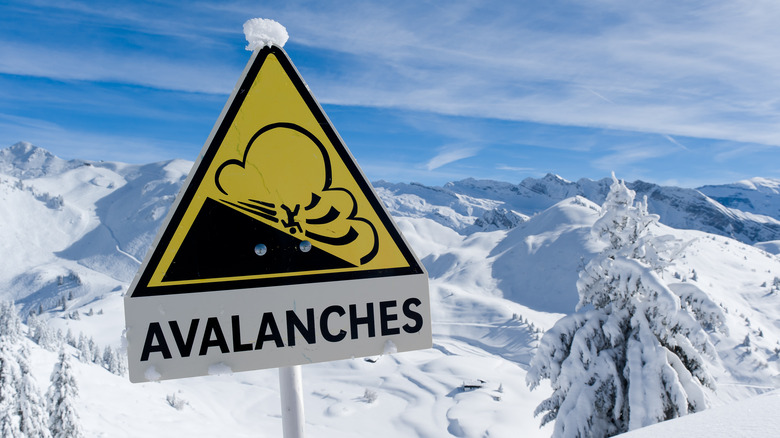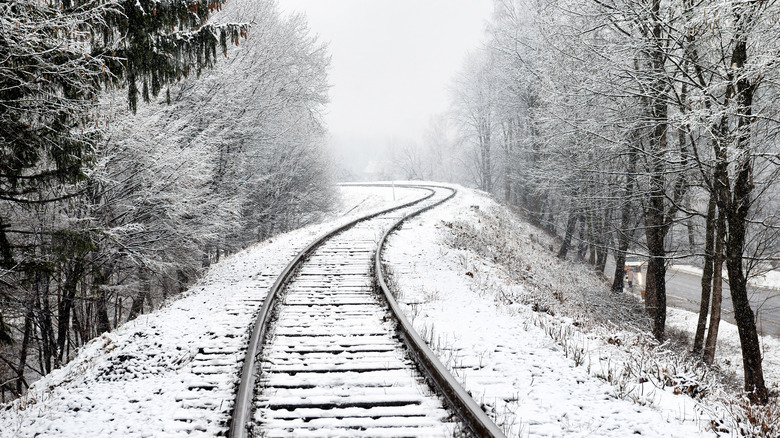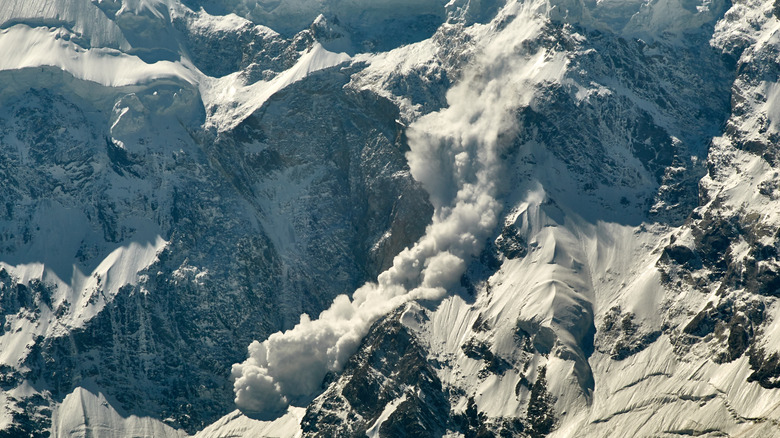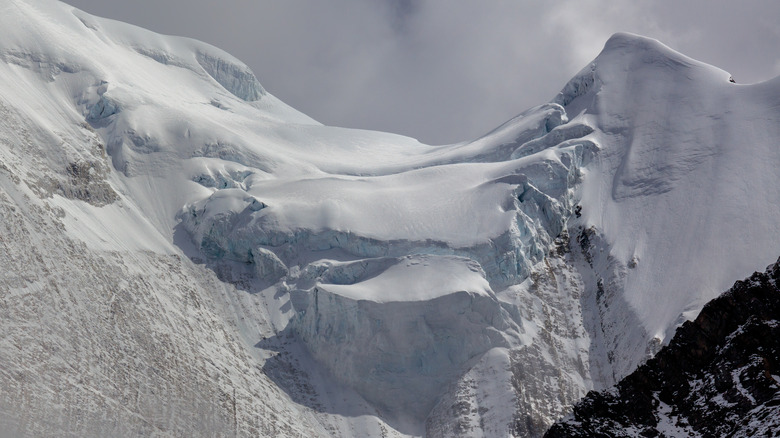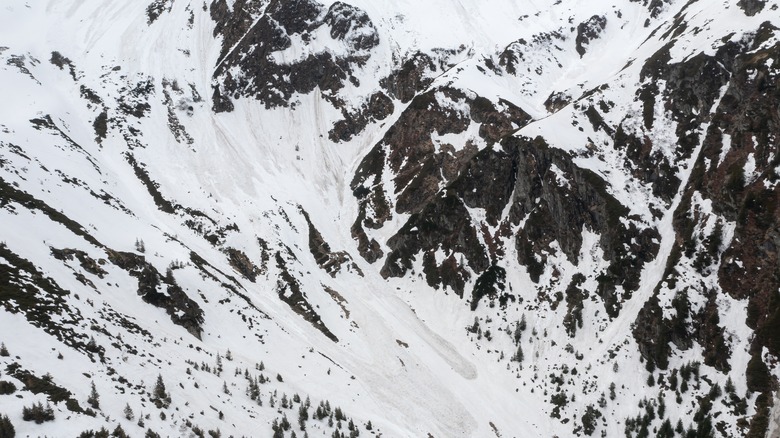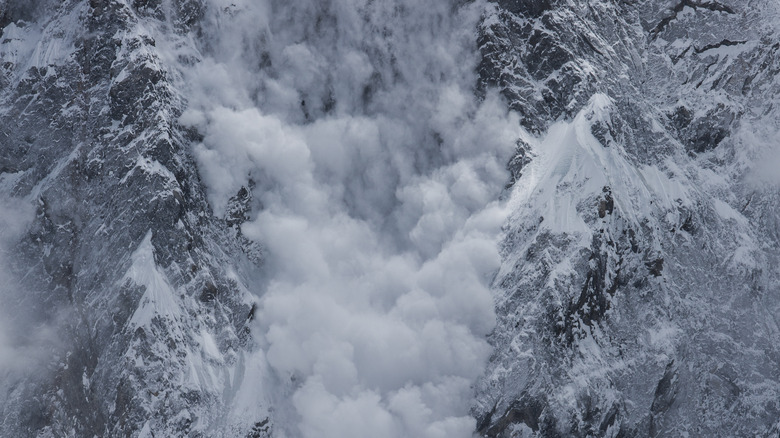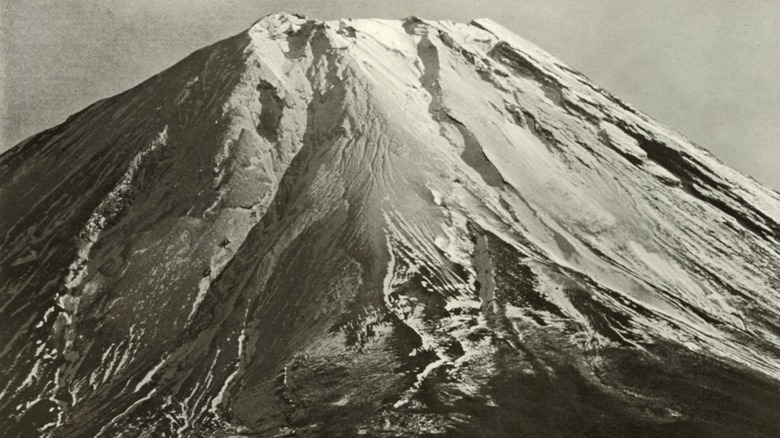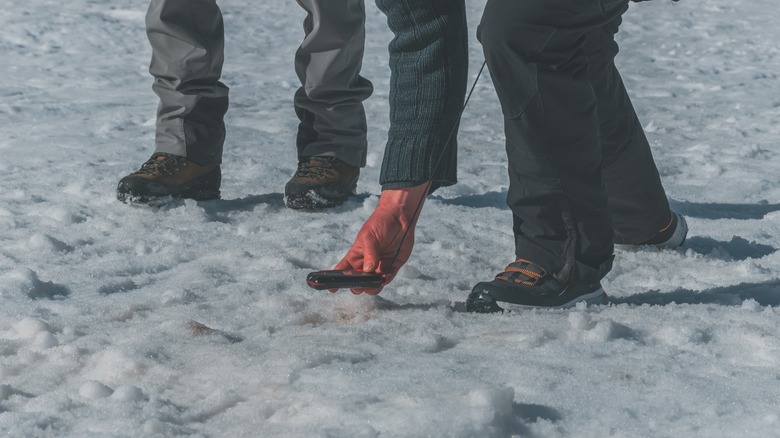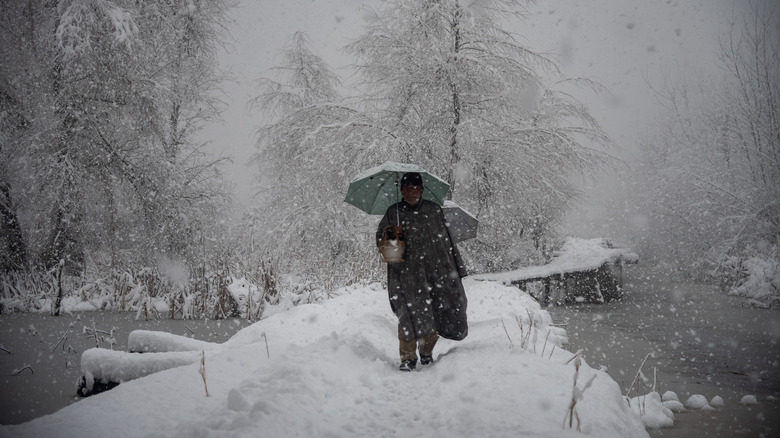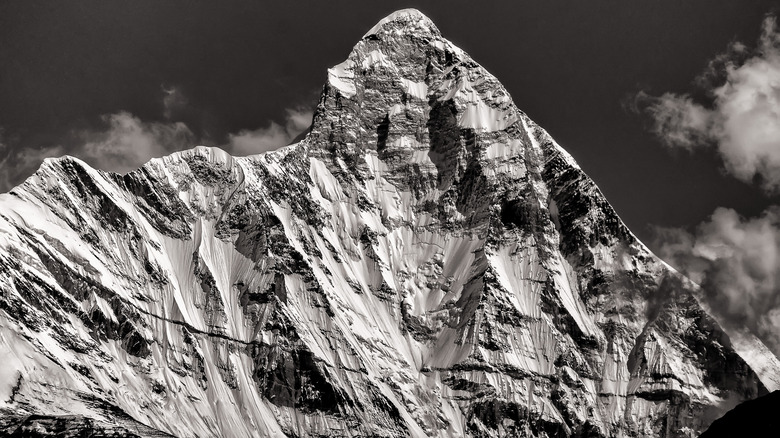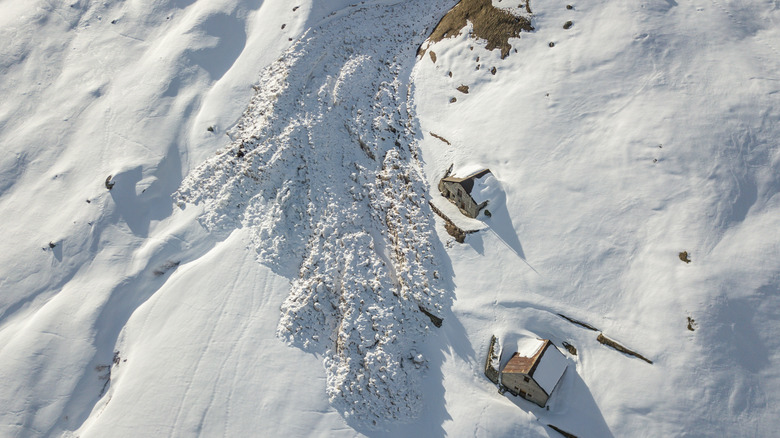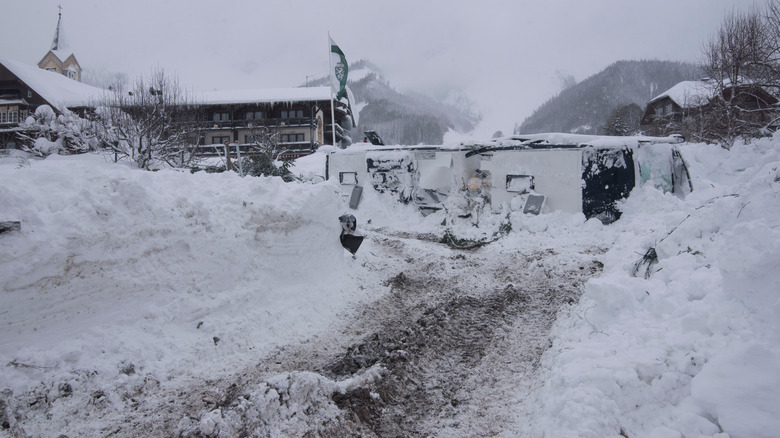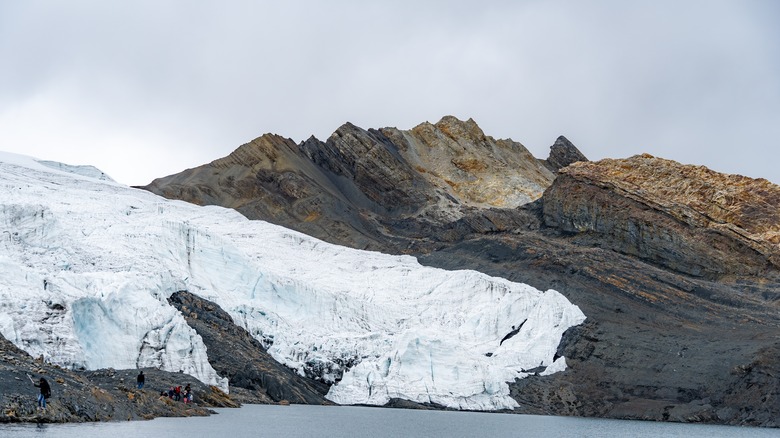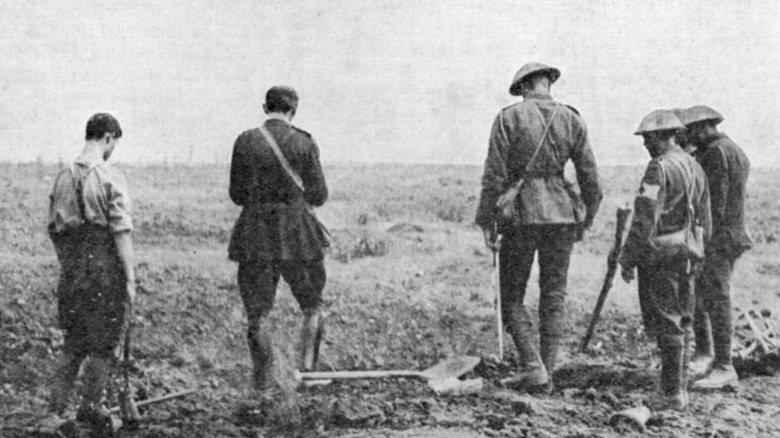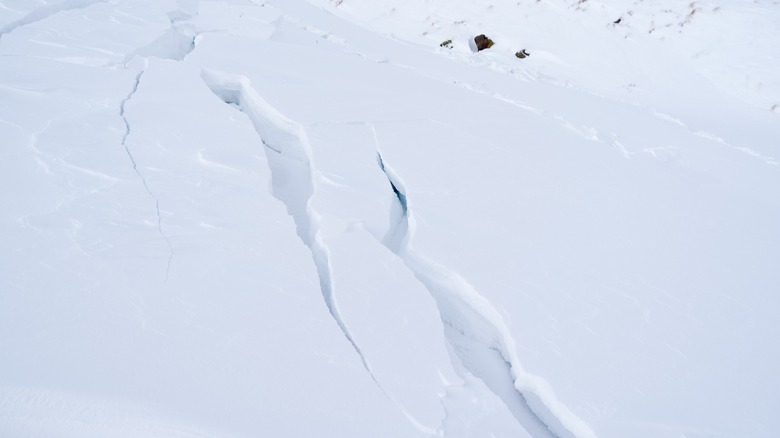The Biggest Avalanches In History Ranked By Most Deadly
Avalanches are not just the stuff of disaster movies. Masses of snow, ice, and debris that thunder down mountains cause devastation more shocking than any special effects.
There are regions of the world where these catastrophes are so common that people brace themselves every winter, and even though many pass without taking any lives, some have caused horrific devastation. In Peru, Afghanistan, and parts of the Alps, entire towns have been razed, with houses, buildings, and people buried beneath the snow. Even modern technology cannot guarantee rescue efforts will come through as fast as they are needed. Sometimes, rescuers are unable to break through the snow and have to dig with shovels and any other equipment they have. There was one instance where they had no choice but to use their bare hands.
Some avalanches have been so destructive that the true death tolls may never be known. Bodies buried beneath almost unfathomable amounts of snow and debris cannot be recovered, and there have been reports of cars being knocked into gorges and victims' remains being swept up by floods. This is the worst snow can get.
Wellington avalanche, 1910
Even though snow is expected in the Pacific Northwest, the deadliest avalanche that ever struck the U.S. was unexpectedly vicious — especially for train operators and passengers.
Travelers headed from Seattle to Spokane had no idea what they were in for when mounds of snow blocked the Great Northern Railroad in late February 1910, according to The Seattle Times. They held out for a while as they helplessly watched snowdrifts pile up to 10 and eventually 20 feet high in the mountains. The sky bellowed with thunder and crackled with lightning. Enter the Great Northern's William Harrington, otherwise known as the Snow King. He sent snowplow crews to clear the railroad, but despite their best efforts, the trains remained stranded. In the early-morning hours of March 1, a 14-foot wall of snow hurtled down from the side of a mountain and knocked the trains into a gorge more than 100 feet below.
The only way to recover the wounded and dead was to shovel them out of the snow-covered wreckage. The Wellington avalanche took 96 lives. Thirty-five of them were train passengers, with the other 61 being train and snowplow workers who were just trying to plow through the catastrophe.
Kohistan avalanche, 2010
Winters in Pakistan are fraught with avalanches. They strike every year, but the Kohistan district in the country's mountainous north suffered one of the deadliest in 2010.
According to the Pamir Times, a local news outlet, remote villages in this district suffered the most. Some villages were literally buried in snow. Residents were quickly running out of food and drinkable water, and panic set in when it became difficult to breathe under so much snow. Rescue efforts were ordered by the government, but there was a severe lack of resources. Rescuers tried to deliver as much food and water to the village as possible, along with providing access to fresh air. The storm that caused the avalanche was so ferocious that helicopters could not make it through.
Snow was not the only source of terror. In the wake of this avalanche came a landslide. The mayor of Kohistan also admitted to being nervous about mass quantities of snow melting in the sunlight, because it could cause a nearby glacier to crush more victims. At least 102 lives were taken. According to ABC News Australia, snowy conditions made it difficult to reach those in affected areas. Some of the victims ended up buried alive.
Kolka-Karmadon rock and ice slide, 2002
While snow and ice are almost inevitable during a Russian winter, a region in the Caucasus mountains experienced a massive rock and ice slide that crushed any earlier catastrophes.
The onslaught of ice and hunks of rock would eventually bring on a mudslide. It started in North Ossetia, Russia, on the night of September 20, 2002, according to a group of researchers who published a study in Journal of Glaciology. The culprit was Mount Dzhimarai-Khokh. Huge slabs of rock that were loosened from the top of the mountain came tumbling down, taking vast amounts of snow and ice (and even a chunk of a glacier) with them until everything — along with gobs of mud — smashed into the village of Karmadon. The frozen, muddy mass continued farther, and 120 people eventually perished. These deaths were thought to have been preventable since the region had experienced similar events in the past.
Another study, published by a different group of scientists in Natural Hazards and Earth System Sciences, mentions as many as 140 victims. That study also describes the destruction of roads and buildings, along with floods that resulted from debris that tumbled into lakes and dangerously raised the water level. The Kolka-Karmadon disaster was the worst ice avalanche to ever crash through Russia, and the largest in recorded history.
Gormec avalanche, 1992
In the mountains of southeastern Turkey, the Kurdish village of Gormec was nearly obliterated by an avalanche that crushed half its stone houses. Other regions were also battered.
As one resident told a Turkish news agency (via the Los Angeles Times) at the time, people were desperately trying to dig their houses out of the heavy snow, when "suddenly there was a loud boom like a cannon shot, and it seemed like the whole mountain was coming down on us." As the Los Angeles Times also says in the same 1992 article, it was impossible for rescuers to even reach the scene until the next day. Stranded villagers had to be left to their own devices. Soldiers shoveled right beside civilians, but not everyone could be saved. The disaster ended up taking 135 lives, by some estimates. When the Times article was published, it was thought the death toll could have been as high as 170.
This was not the only avalanche to pummel Turkey that year or that decade, as researcher Tayfun Kurt revealed in a study, published in the journal Natural Hazards and Earth System Sciences, on a series of lethal avalanches from the 1990s through the 2010s. According to Kurt, 1992 was an especially deadly year, with 158 avalanches that killed 453 people.
Gayari Sector avalanche, 2012
If it seems that there couldn't have been a worse avalanche in Pakistan than the Kohistan avalanche, there unfortunately was.
The Gayari avalanche slammed into a Pakistani military base in the early hours of April 7, 2012, as The Guardian reports. What really took rescuers by surprise was the location. Despite avalanches being common in the mountains of Pakistan, military compounds usually escape them. This particular base was in a deep valley close to the Siachen Glacier. It is already a hostile place, especially freezing in the winter and blowing with vicious winds. The altitude is high enough to induce nausea. Bodies were still being recovered at the time that The Guardian's article was published.
Mounds of snow and ice claimed the lives of 129 Pakistani soldiers, as well as 11 civilians, for a death toll of 140, according to the BBC. Some 70 feet of snow strained rescue efforts. Though rescuers were dispatched immediately after news of the avalanche broke, the only way to recover bodies and survivors buried under so much snow was to tunnel through; ultimately, no survivors were found. In the wake of the tragedy, some have called for troops from both India and Pakistan to be withdrawn from the area despite an ongoing rivalry between the two countries for control of the glacier.
Mitsumata Village avalanche, 1918
There hasn't been a deadlier avalanche in Japan in more than a century — and back then, there was not as much technology to communicate or deal with the damage it left behind.
Half an hour before midnight on January 9, 1918, an avalanche descended on Mitsumata Village in Niigata Prefecture on the Japanese island of Honshu, according to a study published in the Journal of the Japanese Society of Snow and Ice. The crushing snow easily demolished 34 houses in the village and killed 158 people. To better understand what happened, a team of researchers who published a study in Journal of Glaciology created a simulation of the disaster. They found that the snow was able to travel farther as friction beneath it lessened. This explains how it was able to extend almost a thousand feet.
It was partially because of this event that avalanches have been studied extensively in Japan since the 1930s. The studies are meant to help prevent future death and destruction, but low public works budgets often mean there is not enough funding for preventive measures.
Salang avalanches, 2010
The Middle East may be known for its scorching sands, but in the winter, higher altitudes that are already covered in snow face a stormy forecast. These storms often trigger avalanches.
Avalanche after avalanche — 17 in all — struck the Salang Pass near Kabul in northern Afghanistan starting February 8, 2010, as The New York Times reports in an article published a day later. The pass is a staggering 12,000 feet high. Furious winds and rains pushed snow down the mountains above a highway tunnel, where cars were either buried in the snow with no way of escaping or, in the most extreme cases, swept into a nearby gorge. Afghan and NATO troops were dispatched to the Salang Pass to try and dig out as many trapped drivers as possible.
Even 500 soldiers were not enough to clear 2.5 miles of highway. It got to the point that interior minister Mohammad Hanif Atmar pleaded that anyone with heavy equipment, such as snowplows or blowers, allow the government to rent it because rescuers did not have enough to finish this massive undertaking. Exposure to the elements and potentially lethal exhaust fumes also threatened lives. According to CCTV, 171 perished in the avalanche.
Afghanistan avalanche, 2012
Afghanistan has seen worse devastation than the Salang avalanches. Just two years later, so much snow fell from the mountains that an entire village vanished beneath it.
This avalanche struck the small village of Sherin Nazim, in one of the poorest areas of Afghanistan, on March 4, 2012, as a New York Times article published several days later reports. Survivors struggled to stay alive for three days while rescuers desperately tried to reach them. With necessities running dangerously low, lives were at risk. As soon as people from nearby areas heard of the disaster, they rushed over to help in whatever way they could, long before rescuers finally made it through the mounds of snow that had caused severe road blockage. Even an aircraft failed to reach the affected area. Some had no choice but to head to Sherin Nazim on backroads they had to travel on foot, carrying supplies with them.
Unfortunately, the lives of many villagers were taken by the avalanche. While the known death toll was 56, according to ABC News Australia, 145 more people were missing and, by March 10, assumed to have perished. That brings the death toll to 201. The winter of 2012 was thought to be the roughest Afghanistan had seen in 15 years — but it still wasn't its most fatal.
Lahaul Valley avalanche, 1979
Mountainous regions like India's Lahaul and Spiti district will always be prone to torrential snow, and with snow and hulking mountains can come avalanches of great magnitude.
Several avalanches that happened within days of each other dumped massive amounts of snow on the Lahaul Valley and surrounding villages, according to a study by geographer Vishwa B.S. Chandel, published in the International Journal of Geomatics and Geosciences. Nothing remained of three of these villages after the storm that sent tons of snow crashing down, and parts of a revered temple were also destroyed. The series of avalanches that devastated the region left as many as 237 fatalities in its wake.
The entire state of Himachal Pradesh, where the Lahaul Valley area is located, is infamous for these disasters, as a presentation by the Himachal Pradesh State Council for Science, Technology, and Environment warns. Human settlements that cause soil to erode faster have only heightened the risk. More than half of Himachal Pradesh is vulnerable to erosion, and when the soil beneath heavy snow on mountains breaks down, the snow loosens and comes sliding down the slopes. The report states that avalanches ravage the Lahaul and Spiti district every winter, often blocking or completely burying roads.
Winter of Terror, 1951
The second deadliest avalanche event that ever descended on Europe came rumbling down from the Swiss, Italian, and Austrian Alps, as The Guardian reports. The season known as "the Winter of Terror" lived up to its name, with thousands of avalanches crashing through the region.
As if there wasn't already enough snow in the Alps, the area had been hit with twice as much as usual that winter, and a storm brought tons more between January 19 and 21, 1951. Ruthless winds blew through the mountains and sent snow hurtling down. Some areas suffered more than others. Houses, buildings, and railroads were wrecked before anyone had a chance to flee, and entire towns went dark. It took just an hour for six avalanches to nearly obliterate a town in Switzerland. All told, 265 people are known to have died, per The Guardian. According to a 1951 study published in the Royal Meteorological Society's journal Weather, some areas were so congested with snow that it was as if they were under siege.
The study also documents something disturbing about the prediction of such extreme inclement weather. Meteorologists were nervous about the impending onslaught of snow a month before the disaster, and those predictions turned into a waking nightmare when parts of the Alps that already had the deepest snow were pounded by avalanches.
Afghanistan avalanche, 2015
Snow has been especially cruel to Afghanistan, but this beast of an avalanche that trampled through the country's northeastern mountains was the most dangerous that ever struck.
In an article published a day after the disaster began on February 24, 2015, The Guardian reports that roads were cut off, people were buried alive, and so much snow had fallen on the Panjshir province that it crashed into about 100 homes. The Salang tunnel, which had been bombarded by snow and ice in 2010, was closed. Roads that had been cleared to some extent were clogged with traffic that could barely move. Rescue teams were unable to reach some areas for days, with more helpless victims either succumbing to the cold or being crushed in their own houses and cars as precious time passed.
Rescuers who did reach victims sometimes had to resort to shoveling with their bare hands. It only grew colder, and the search for survivors turned into the search for bodies. The Los Angeles Times gives a death toll of 285, with 196 of those lives being lost in Panjshir. Even by early March, it was still nearly impossible for military and medical help to get to more remote areas.
Huascarán avalanche, 1962
Not to be confused with the more lethal Huascarán debris avalanche that happened eight years later, this avalanche was the terror that came from an extinct volcano.
Volcanoes that no longer erupt can still be dangerous. Mount Huascarán proved this when, according to History, a 6-million-ton chunk of an attached glacier cracked off, rumbled downhill, and shook the Rio Santa Valley when it landed with a tremendous thud. The speed of the avalanche was something no one was prepared for. Residents were aware the area was prone to avalanches, and they knew that after the initial sound of the ice breaking away, they usually had about half an hour to escape. It only took seven minutes for this downfall to carve a path of death and destruction through two entire towns.
In a study published in Developments in Geotechnical Engineering, researchers note that there had not been a disaster of such magnitude recorded before 1962. It also led to a flood when nearby Rio Santa river became clogged with snow and ice, and the water level kept rising until it gushed forth. History says there were 4,000 casualties — some of whom were buried deep beneath the rubble or swept away by the swollen river.
White Friday, 1916
During the tragedy that became known as the Great War, or World War I, one enemy that claimed the lives of thousands of soldiers was an immense avalanche.
War was not the only thing threatening troops in the Italian Alps in December 1916. As History remembers, in the midst of the fighting between Italian and Austrian troops near the Austrian border, there came powerful winds and a downpour of snow, and several avalanches soon tumbled down Mount Marmolada. Some who were taken down by the disaster were not even fighting, but manning the barracks directly below the mountain. A study published in the official journal of the European Center for Medium-Range Weather Forecasts (ECMWF) reports that it had already been snowing heavily for a week before the battleground was hit, and so much snow accumulated that it caved under its own weight.
What made the snow so severe was an onrush of warm, humid air from the south. It only created more precipitation. Bodies were buried so deep that nobody knows the actual death toll. It has been estimated that up to 10,000 Italian and Austrian soldiers died not from grenades or gunshots, but deadly snow.
Huascarán debris avalanche, 1970
Set off by an earthquake that did enough damage on its own, this avalanche happened after the earth trembled, setting a barrage of snow and ice free from Mount Huascarán.
The Huascarán avalanche is the worst known avalanche ever witnessed. The Air Mobility Command Museum reports that an entire mile of ice and rock broke off from the mountain and an adjacent glacier and moved at 100 miles per hour, picking up more and more debris along the way. It kicked up landslides and mudslides as it made its perilous journey through the Callejon de Huaylas valley, and much like the 1962 avalanche that came from the same mountain, clogged rivers that ended up overflowing. There was so much devastation that the wreckage from destroyed houses, buildings, and other structures only added to the debris that rescuers had to brave in order to reach people in urgent need.
There is a reason the earthquake that caused this avalanche is also known as the Great Peruvian Earthquake. According to the BBC, all that was left of the town of Yungay was a stone statue in a graveyard. Besides a few trees, the rest had been reduced to rubble. An estimated 70,000 people are thought to have died.
